They have brought with them their anger and aspirations, their dreams and demands, their clarion calls for justice. They can be heard in their chants and seen in their sheer numbers, but the messages they bring are perhaps most vividly illustrated by the signs they hold aloft as they march. Since George Floyd’s death late last month, millions of demonstrators have flooded the streets of America’s cities to protest police brutality and the racism that has defined the nation since its founding. Many of them have turned to cardboard to make sure there’s no mistaking exactly why they’ve come out to protest.
Some signs are a few words or initials scrawled on torn-apart Amazon boxes. Others are intricate works of protest art laid out on on carefully trimmed poster board. Messages are drawn with Sharpie, shaded with pastel, and pieced together with tape. There are funny signs, there are gut-wrenching signs. Signs proudly project protest mantras like “Black Lives Matter” and “No Justice, No Peace,” and the names of George Floyd, Breonna Taylor, and other black Americans who died at the hands of police. They call for President Trump’s removal from office, and the defunding of the nation’s police departments. They are a way for demonstrators to amplify their voices, and to make it known what moved them to rally for justice. From their composition to the messages they carry, they’re as diverse as the crowds toting them through the streets en masse.
On Sunday, Rolling Stone attended rallies in Times Square in Manhattan and Grand Army Plaza in Brooklyn to hear some of the stories behind the signs.
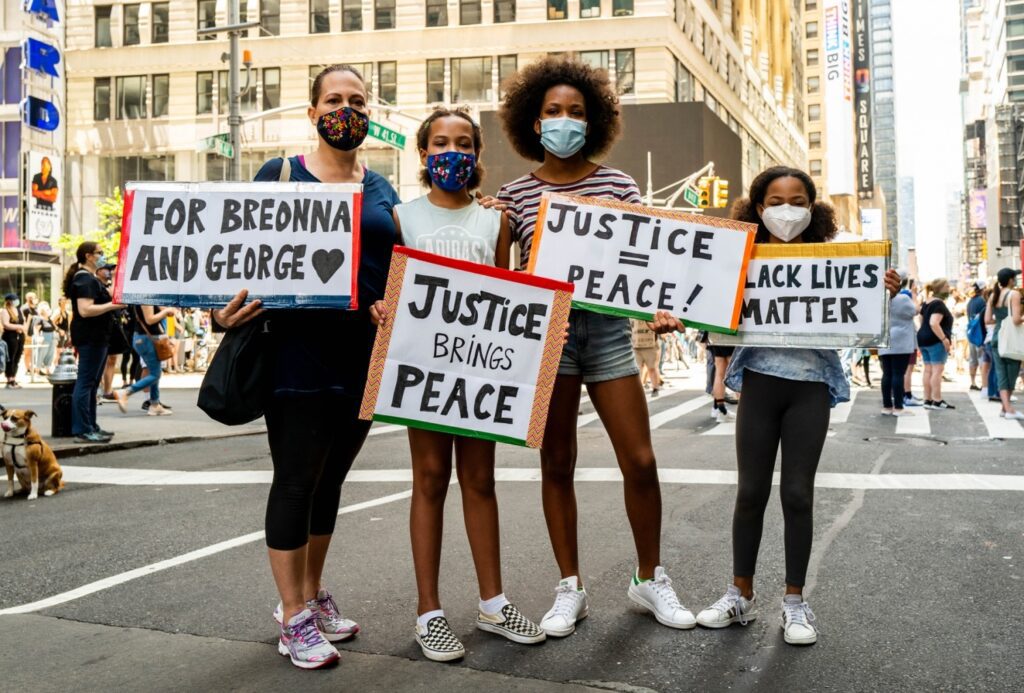
Eva Woolridge for Rolling Stone
Birgit Maier, 51, Simone Benn, 10, Olivia Benn, 14, and Juliet Benn, 10 (Upper West Side)
“We spent last night thinking about what message we wanted to share,” Birgit says. “We’ve been isolating for about three months, and we thought it was time to come out. We are heartsick about all the violence and disrespect toward black people and we’re not going to take it.”
“It makes me very hopeful,” she adds. “I love it when my kids can see that thousands and thousands of people who are standing up for what is right, even though we see some bad behavior by the president and some police — it’s incredible that they think they can get away with it while the cameras are rolling. So more of us need to stand up, more good people than bad.”
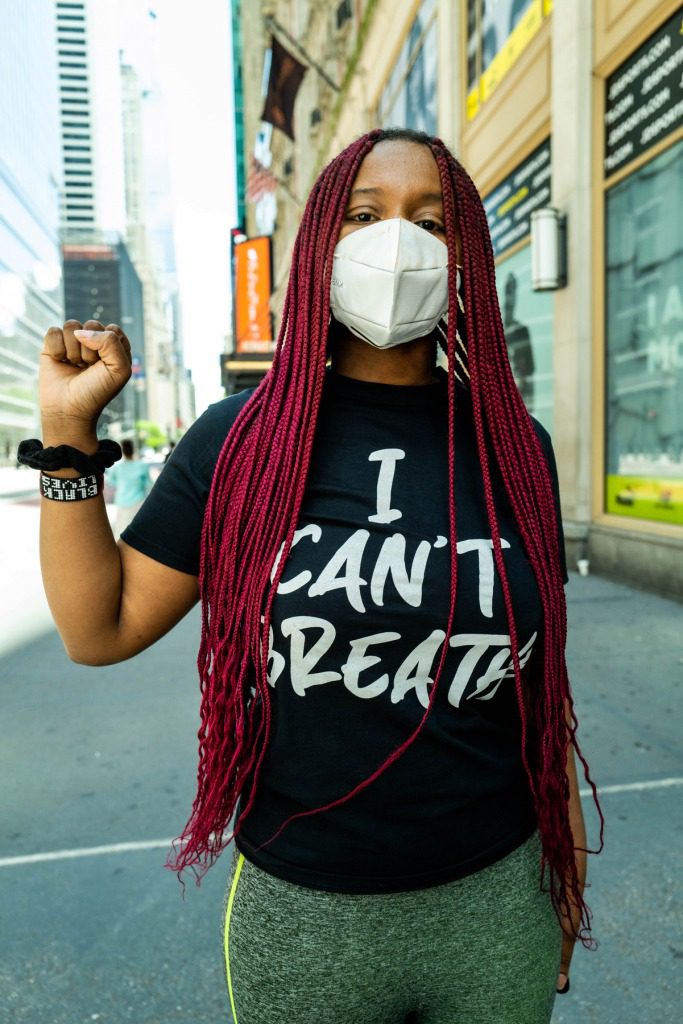
Nupol Kiazolu of Black Lives Matter of Greater New York
Eva Woolridge for Rolling Stone
Organized by Black Lives Matter of Greater New York, the rally in Times Square was aimed at outlining a legislative “blueprint” the group would like to see enacted by lawmakers. Nupol Kiazolu, the 19-year-old president of BLMGNY, spoke with Rolling Stone prior to the event on Sunday morning. “We’re not just out here protesting,” she says. “Protest without strategy is an empty threat. We have to give the community strategy to organize around, and our agenda is always open to review by and for the community.”
“My favorite sign said, ‘You’ve Fucked With the Wrong Generation,’” she adds of the messages she’s seen since the demonstrations began. “One thing about Gen-Z is we’re going to pull up. I’m so happy to see this many young black people mobilizing and organizing on the ground in the name of justice. It’s time for the adults to step back and let young people lead and support us. We’re not only the future, we’re the present. We’ve been doing the work and we’ve shown that we’re more than capable of effectuating change. That’s exactly what we’re going to do. We’re not going to stop marching. We’re not going to stop raising hell. When I say, ‘No Justice, No Peace,’ I mean that.”
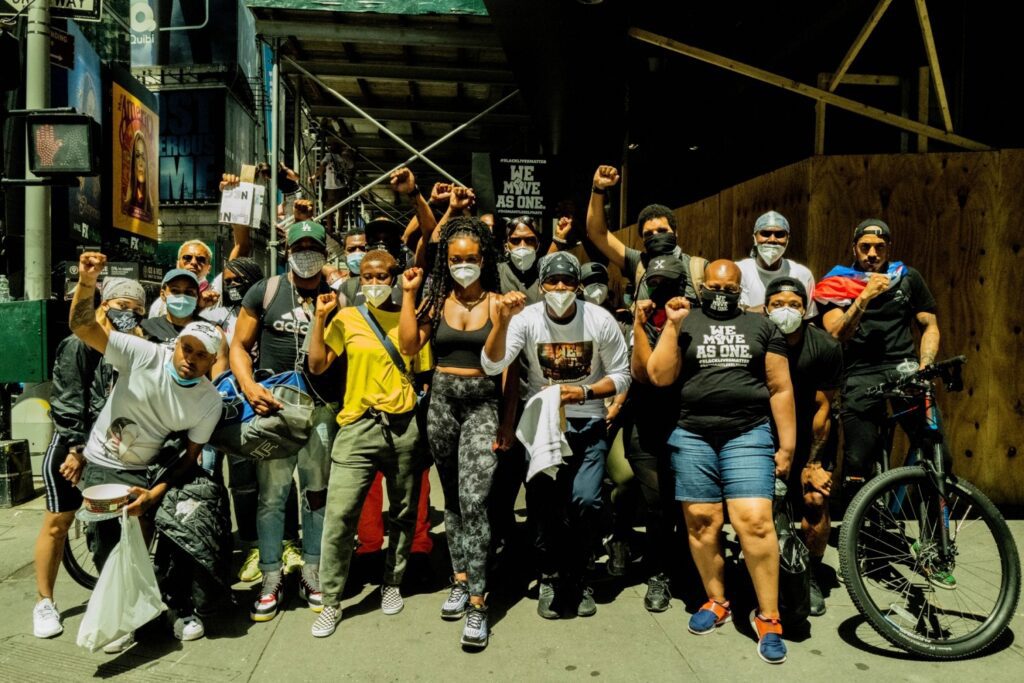
Eva Woolridge for Rolling Stone
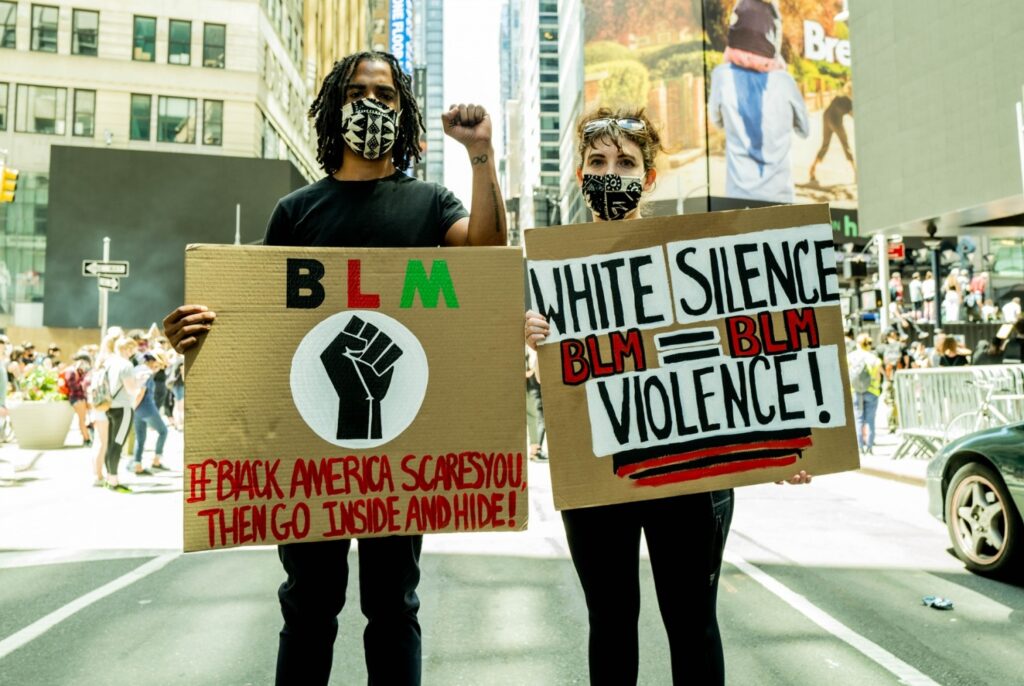
Eva Woolridge for Rolling Stone
Chad Douglas, 31, and Nicole Beauchaine, 32 (Astoria, Queens)
Chad: “I put the Black Power fist because it’s a strong symbol. Ever since the first civil-rights movement it’s stayed constant with the message that we’re united, we’re strong, we’re powerful. I also wrote, ‘If Black America scares you, then go inside and hide.’ We’re in America and black people are part of America. It’s always going to be that way, so get progressive with it or go inside and hide.”
Nicole: “It’s my responsibility as a white person to do everything I possibly can to call out what I see wrong with our system. I’m an educator, I’m a teacher, and every single one of my students is a person of color. How can I possibly educate them if I don’t educate myself? I’m an educator in the south Bronx and they deserve better. If I am going to be lucky enough to teach them, then I need to be the kind of person that can do something to make a difference, even if it’s cutting up some cardboard and writing on a sign. I can’t look them in the eyes if I can’t stand up for them.”
Chad: “I’m hopeful, but to tell you the truth it’s the same narrative time and time again. A black person gets hurt or killed or his freedoms are infringed upon, and there’s protest and it changes for a little while. But within a couple of weeks everyone gets over it and it’s back to the status quo, it’s back to the systemic stuff that you keep fighting over and over and over again.”
This rally in Times Square is the first demonstration Chad and Nicole have attended. They have a child at home. “We need to make sure he’s safe and understands the climate of what’s going on right now,” Chad says. “We didn’t want him worried that Daddy might not come home that night, or Daddy might get hurt as a result of police brutality or anything that was going on at the protests.”
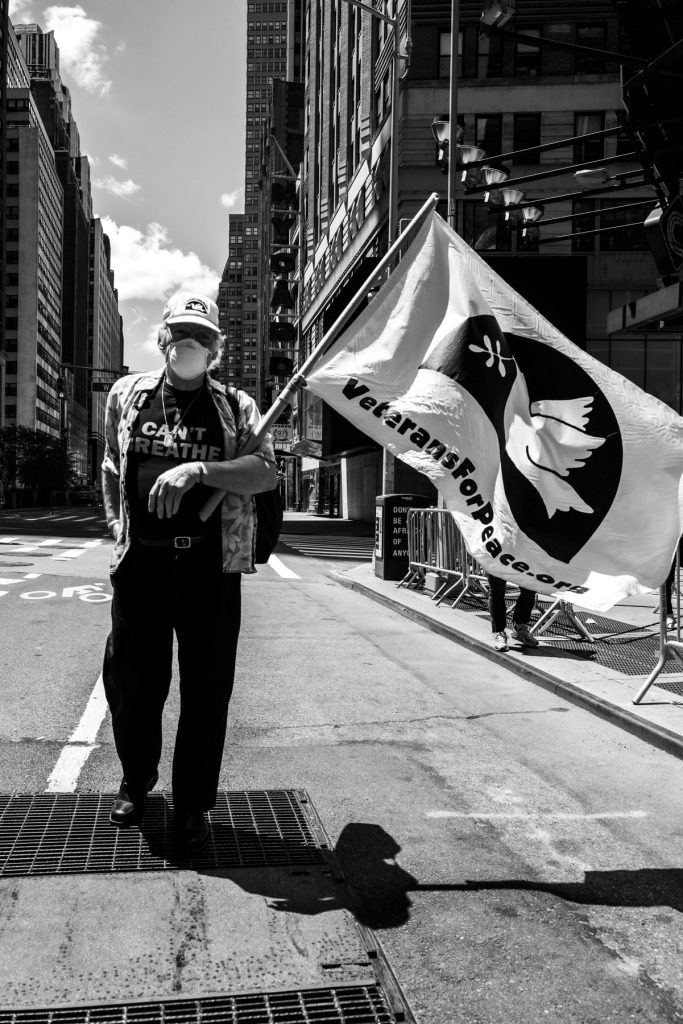
Eva Woolridge for Rolling Stone
Jerry Hassett, 74 (Sunnyside, Queens)
“I’ve been coming out for years,” says Jerry, a Vietnam veteran. “I came out to be in solidarity with everyone else and try and stop all this killing. It’s been going on for 400 years. It’s enough.”
“We have to get the police to change their behavior,” he adds. “You saw a 75-year-old man get thrown to the ground in Buffalo, and they walked past him like he was a piece of shit. It’s got to stop. The young people have to stay out on the streets.”
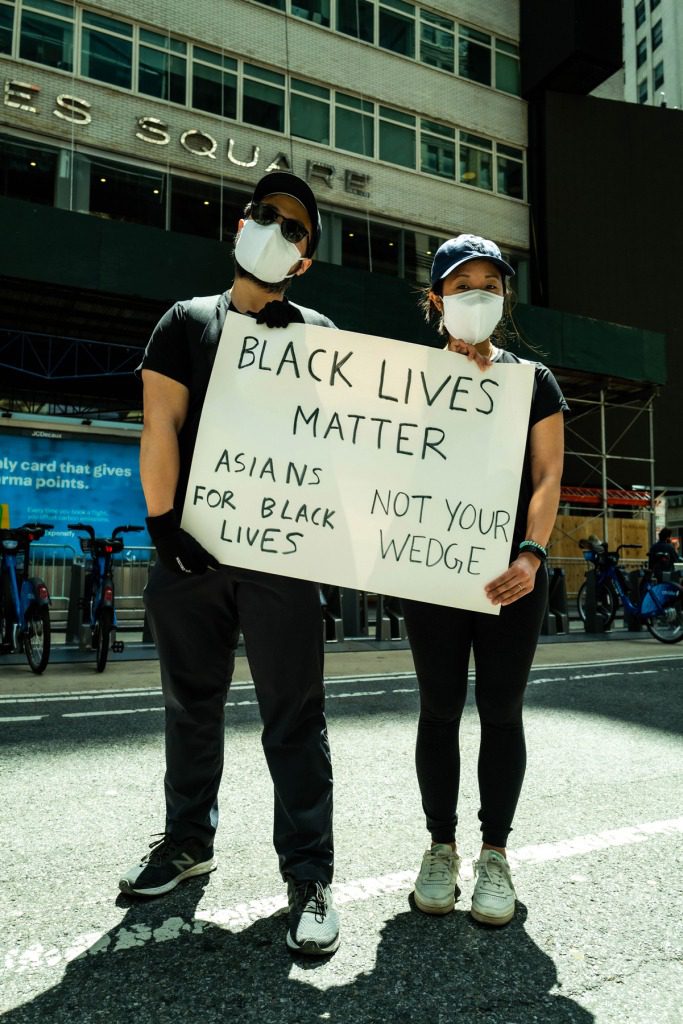
Eva Woolridge for Rolling Stone
Tim, 33, and Angela, 31 (Upper West Side)
“I think it’s important for Asian Americans to really put themselves out there in support of black lives,” Tim says. “Asian Americans are frequently treated as a model minority and a wedge between different groups. Some people are complicit in white supremacy. One name in particular that I think of was at George Floyd’s crime scene, Tou Thao. It’s important we stand for justice. It’s not just a black and white issue. Justice for black lives is justice for all of us.”
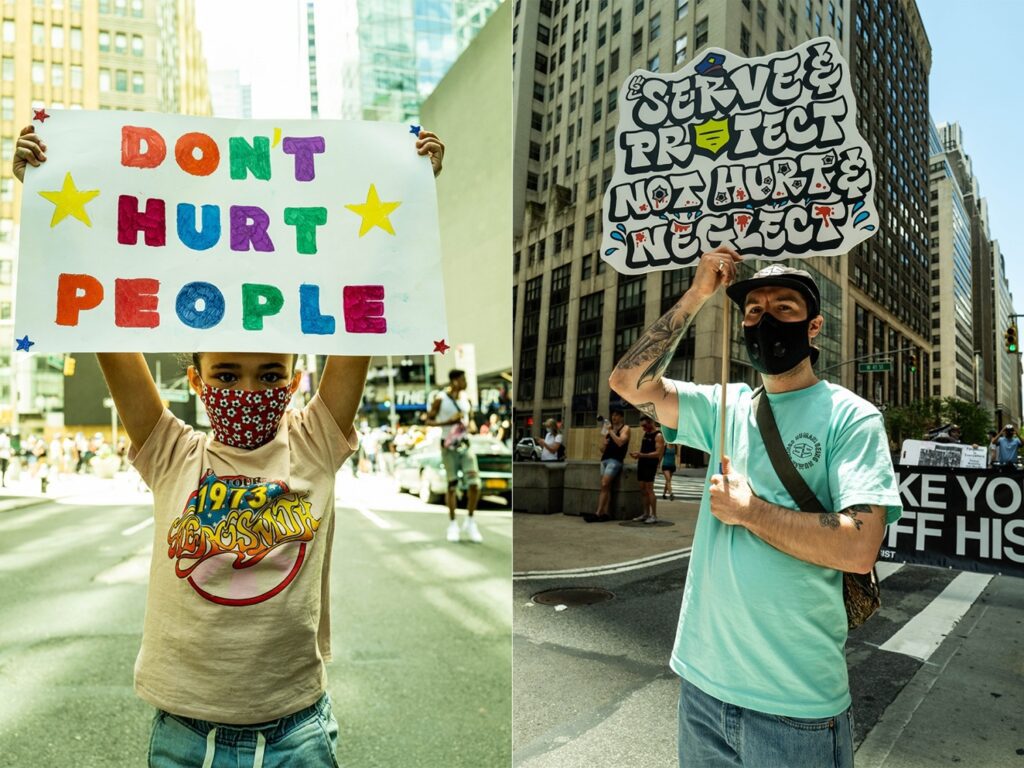
Eva Woolridge for Rolling Stone
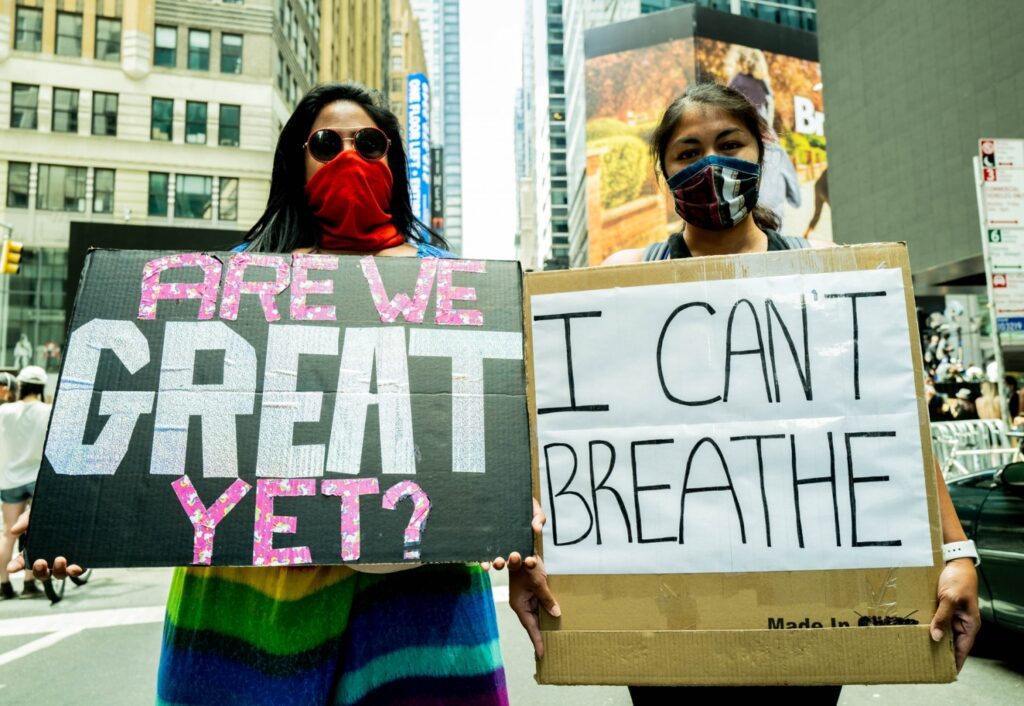
Eva Woolridge for Rolling Stone
Diane Vista-Wayne, 33, and Lauren Basco, 38 (Astoria, Queens)
Lauren: “I wrote, “I Can’t Breathe,” on behalf of Eric Garner and George Floyd and all the people that suffered the same fate they did. The police injustice. Not being able to breathe like a normal human being. Their lives were taken from them, their breaths were taken from them.”
Diane: “I grew up in a small town in Iowa. My family and all the people I grew up are still tone-deaf supporters of this administration. This is my question to them: Are we great yet? Clearly we are not, but we’re definitely getting there.”

Eva Woolridge for Rolling Stone
Annika Samuels, 30 (The Bronx)
“I’m an aspiring artist. What I’m trying to capture here is that African Americans have been trying all these years to have a name for themselves. I’m expressing through the blood tears that what happened to George Floyd is not right. Everybody knows it’s not right. He was just asking to breathe … and there was nobody hearing him. This is so you can see him and so you can hear him, and so you can respect us and love us. We do have a voice. We do have an opinion. We want to be treated like equals.
“This was all done by my fingers, no brushes. The dots behind him represent us. We’re standing here and having his back in these times, because we need to be heard. It’s sad that it takes an event like this to actually be heard, but it needs to happen. I think America and the world is starting to really wake up. Just love and peace and that’s it. There shouldn’t be any reason for discrimination, still. It doesn’t make any sense.”
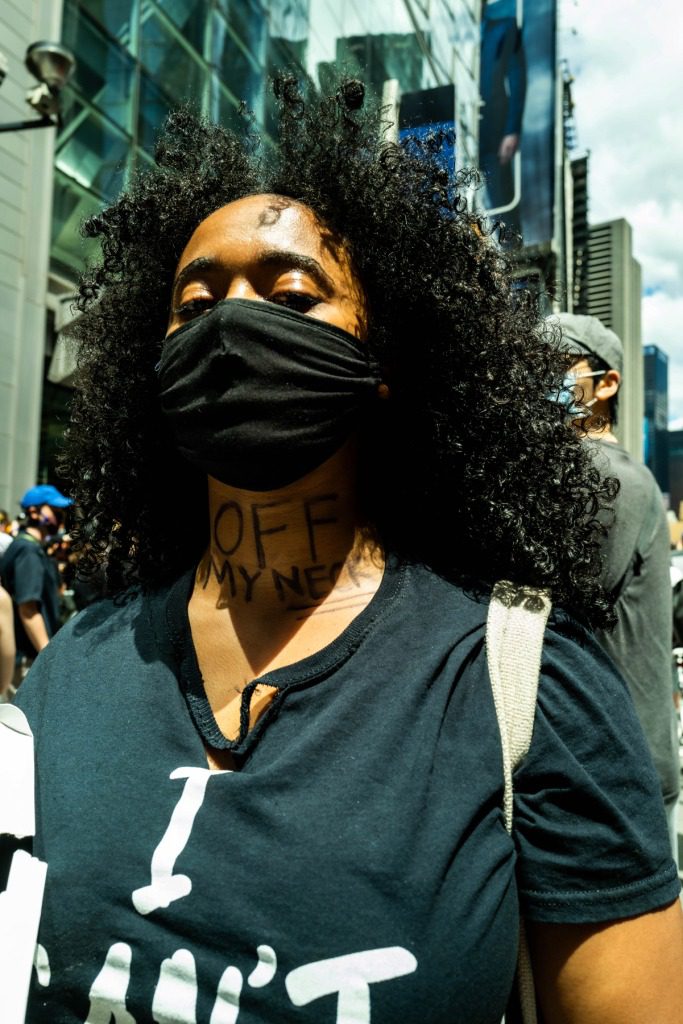
Eva Woolridge for Rolling Stone
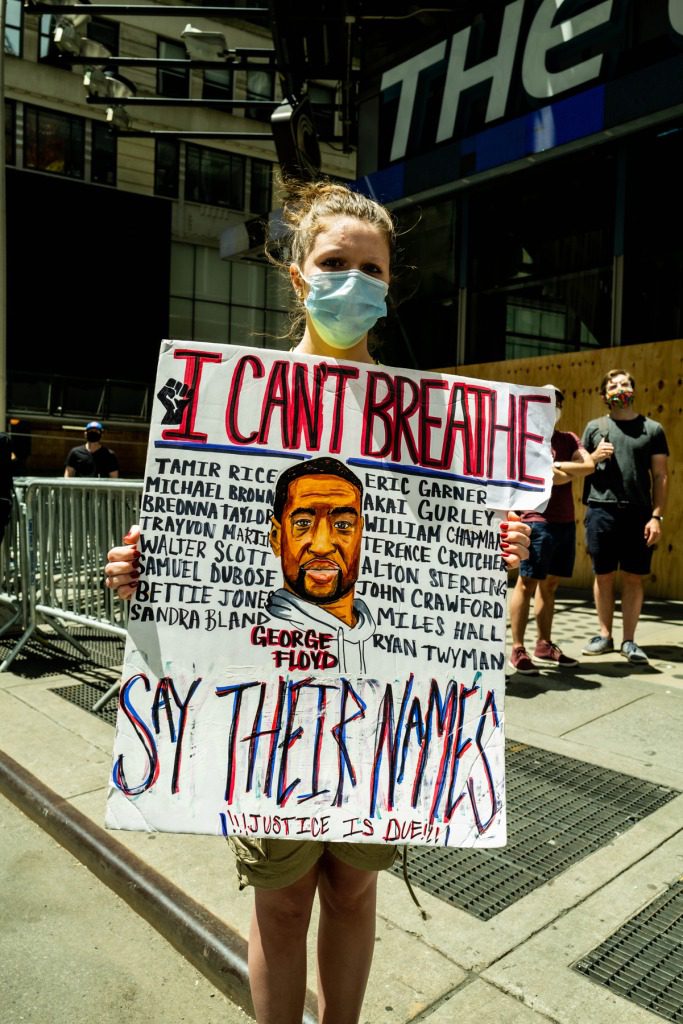
Eva Woolridge for Rolling Stone
Tatum Strickland (Upper West Side)
“I made this sign in memory of George Floyd and the other victims, so their names won’t be forgotten,” says Tatum, a high-school freshman who has brought her sign to multiple protests. “I think too much people overlook and it goes away in a week.”
“I think the system needs to be changed,” she adds. “Black neighborhoods are over-policed and it’s hurting people. Shooting someone is not something you should do on impulse. Being a police officer should not be a job just anybody can have.”
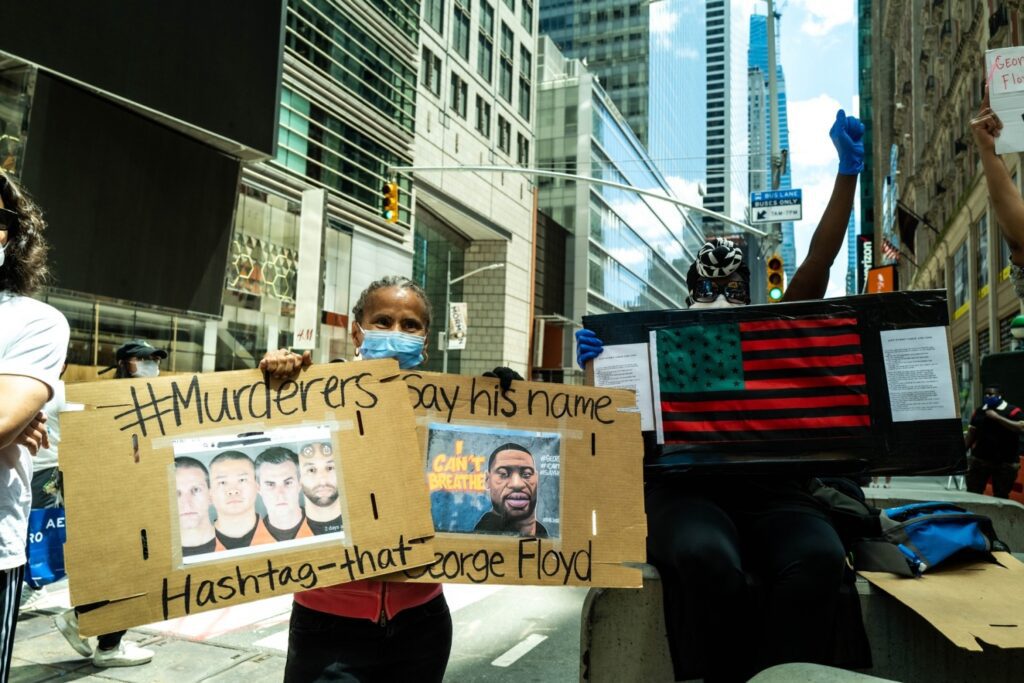
Eva Woolridge for Rolling Stone
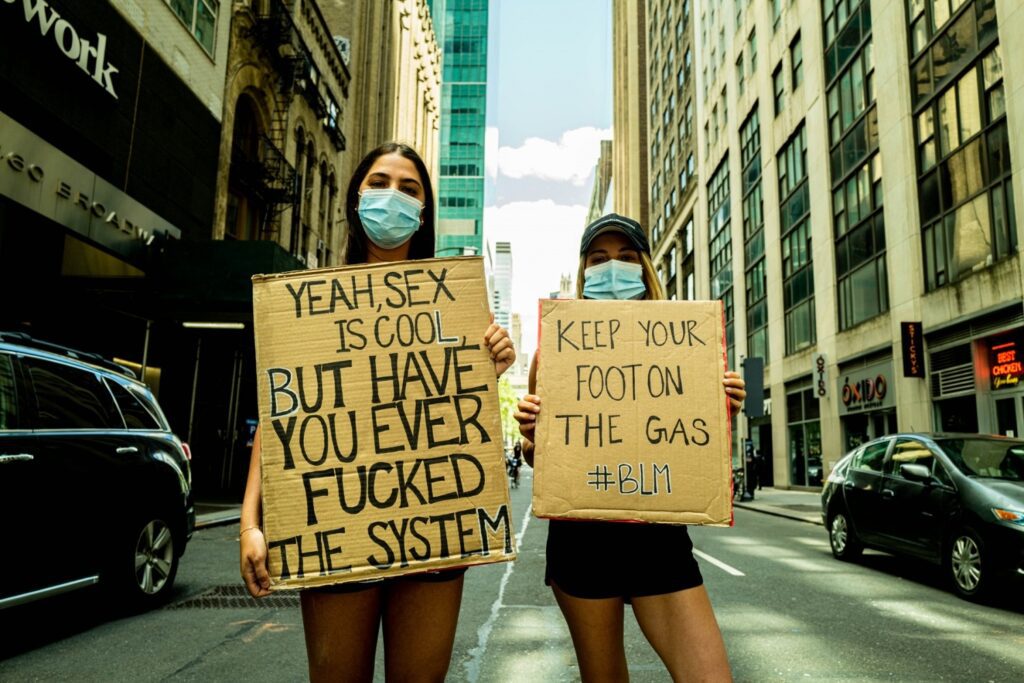
Eva Woolridge for Rolling Stone
Tara Satnick, 21, and Constance Blatt, 24 (Demarest, New Jersey)
Tara: “The message is zero tolerance for any type of systemic racism. I wanted to incorporate a little humor into the sign. There’s obviously a fine line between humor and tragedy, but this felt like my way of protesting authentic to my own voice.”
Constance: “It’s really important to everyone out there to make a difference in their own way, whether it’s protesting, donating money, signing petitions, or just reading and trying to educate and inform yourself. Whatever you’re doing, just keep doing it. It’s not an overnight change.”
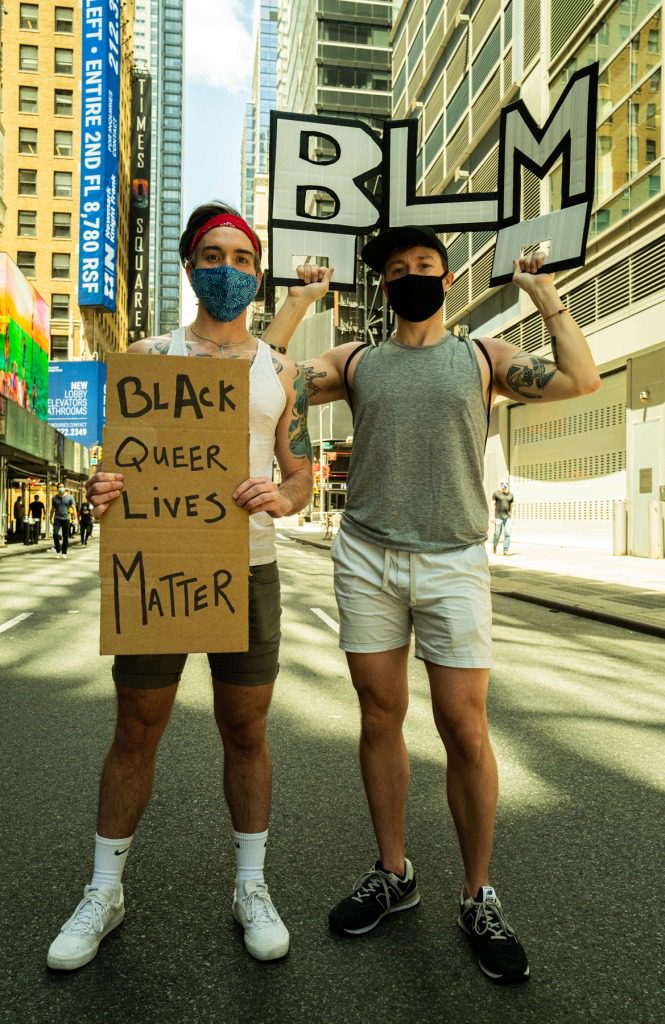
Eva Woolridge for Rolling Stone
Eric Holland, 38, and Conor Maguire, 36, (Midtown)
Eric: “This morning we were talking and I said how disgusted I am with our leadership. I’m frustrated with my friends and family who aren’t furthering the cause, but mostly I’m really embarrassed that it took this for me to be as active as I am today. I’m just thankful that I’m able to be here and be supportive.”
Conor: “I just got tired of watching everything of my phone. This is our first day coming out in person. It’s been something we’ve been talking about all week, and I’m just really happy to be here and excited to see how many different people are here.”
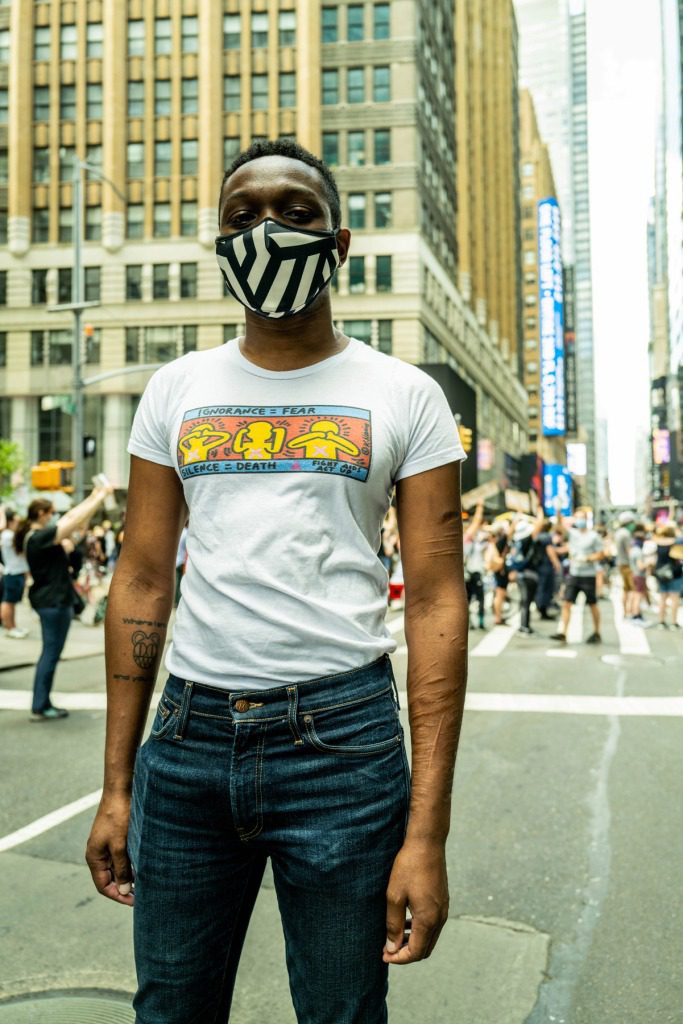
Eva Woolridge for Rolling Stone
Eric Almond, 34 (Astoria, Queens)
“This is a Keith Haring shirt. I bought it at Harlem Pride last year. I wore it today because it represents what we’re going through. It represents what I’ve been going through my whole life. Growing up a black queer kid in America is not something easy to do. I was thrown out when I was 18 for being gay, so I’ve had an interesting life.
“Four years ago I was out protesting a lot when I lived in San Francisco. At the time I felt really hopeful. But it’s hard to feel hopeful when you see this happen every few years. You see police do what they do. You see random citizens attack black people because they’re jogging. It’s hard for me to be hopeful, but that doesn’t mean I’m going to stop fighting and that doesn’t mean I’m going to stop talking about it. It’s great to see people around the world standing up for black lives, but the way these things usually go is that it’s a repetitive thing. It happens every few years. It’s hard to have hope sometimes.”
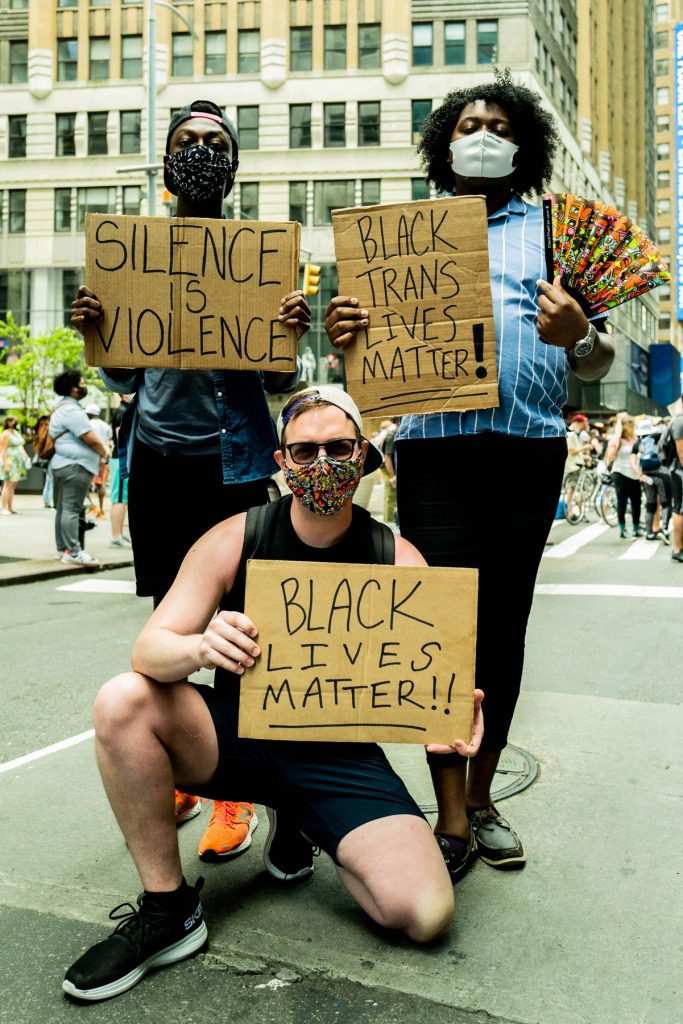
Eva Woolridge for Rolling Stone
Corey Moore, 32, Tyler Wallach, 32, and Sean Craig, 26
Tyler: “It’s a huge honor to be out here today with my friends who are black. I come from a very conservative family in Texas, and this sort of thing is not OK with my parents. I left Texas 10 years ago to be the person I am today.”
Sean: “So many times in the black community, trans people are forgotten. They are a part of this community but they’re often forgotten, they’re beaten, their lives are taken, and no one seems to bat an eye. It’s a problem in our community, so not just black lives, black trans lives.”
Corey: “Now is the time. If we don’t speak up, if we don’t wake up, nothing change and nothing will get done.”
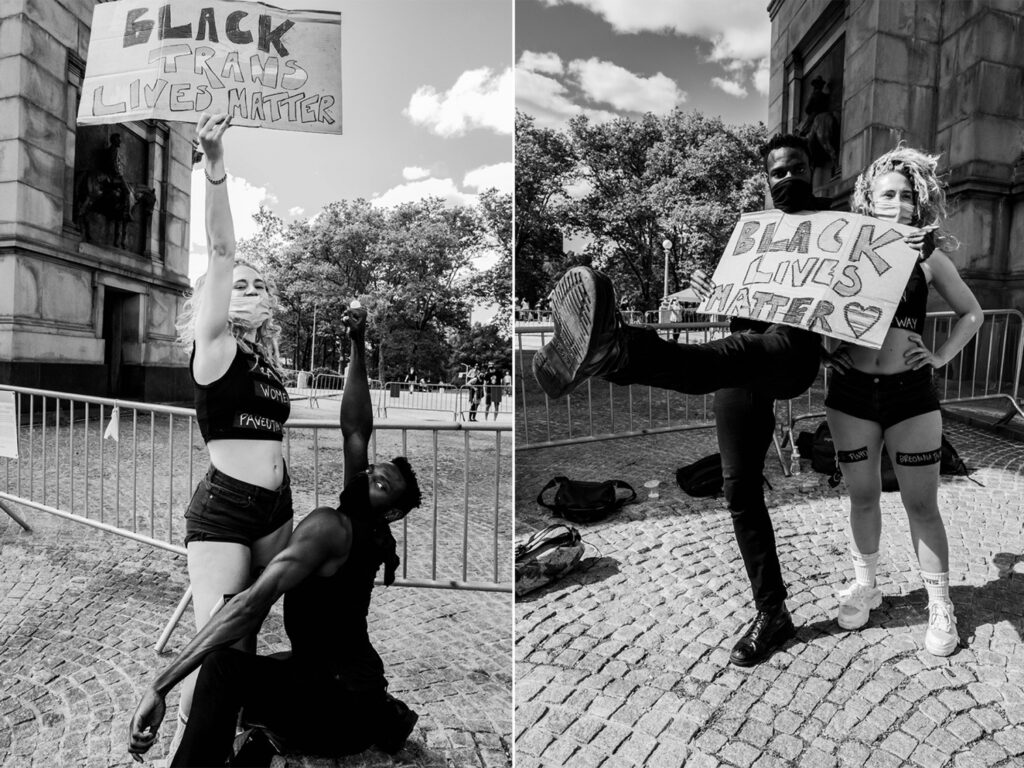
Eva Woolridge for Rolling Stone
Kat Cunningham, 25, and Fabricio Seraphin, 25
Fabricio: “What better way to show how alive we are, how here we are, how present we are, than to show our joy, to be as open and energetic as possible, to be as vibrant as possible?”
Katrina: “To celebrate is a really important part of how to protest. If you’re an artist, you use your art. You don’t necessarily have to write a protest song. Come out with your voice. Come out with your fist. Make a little noise. Do what you do. We dance. That is a contribution. It’s a way of showing up for this cause.”
Fabricio: “I’ve spoken to so many people from all over the world. I got a message from a girl who lives in a small town in Switzerland saying they’re protesting there too. I’ve gotten messages from Iraq and Iran and Mexico. The whole world is coming together for this moment, for us, for the black movement, for equality, for everyone. I think that’s so beautiful, that the world — the world — is coming together for this. There is nothing more beautiful to me. It inspires me. That’s why we still go out. They’re here with us. We have to keep it up.”
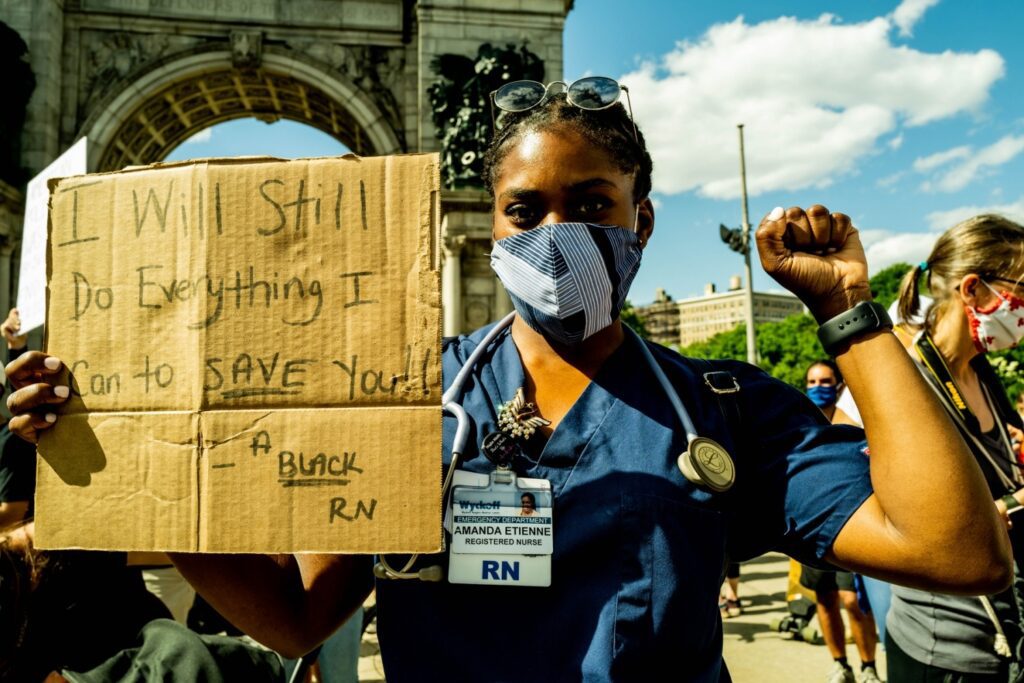
Eva Woolridge for Rolling Stone
Amanda Etienne, 30 (Brownsville, Brooklyn)
“COVID was the worst three months I’ve ever experienced in health care,” says Amanda, an registered nurse at Wycoff Hospital in Bushwick. “Then to come into something like this and witness what you witness on the television, what we all saw happen to George Floyd. It was just like, I can’t believe this is still happening. When I go to work every day I don’t discriminate. We have combative patients. We have psych patients. We have [people with] mental illnesses. We restrain people without having to our them or kill them. It’s hurtful coming from one pandemic and one stress coming into another stress.”
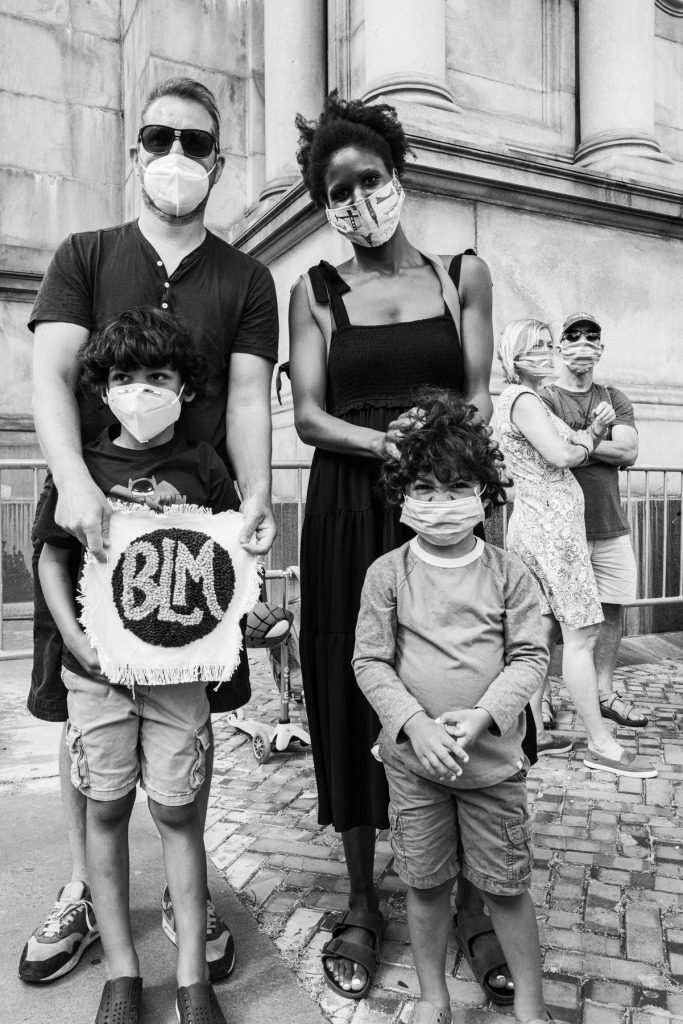
Eva Woolridge for Rolling Stone
Jonathan, Sacha, Charles, and Harry Wynne (Brooklyn)
Sacha: “I just started making things while we’ve been in quarantine. I made this for their room and we thought we’d bring it out.”
Jonathan: “I’m hopeful. I’m really hopeful. It’s been really emotional.”
Charles: “Mom, are they putting us on the news?”
Jonathan: “I’m very, very hopeful.”
Charles: “Dad, are they putting us on the news?”
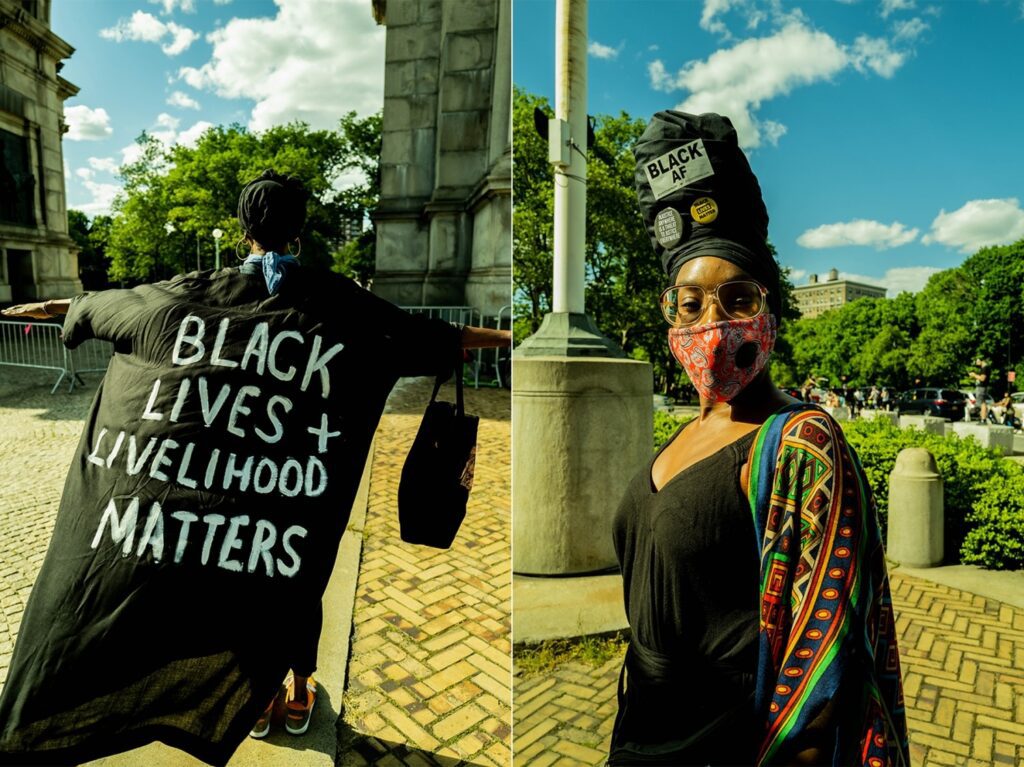
Eva Woolridge for Rolling Stone
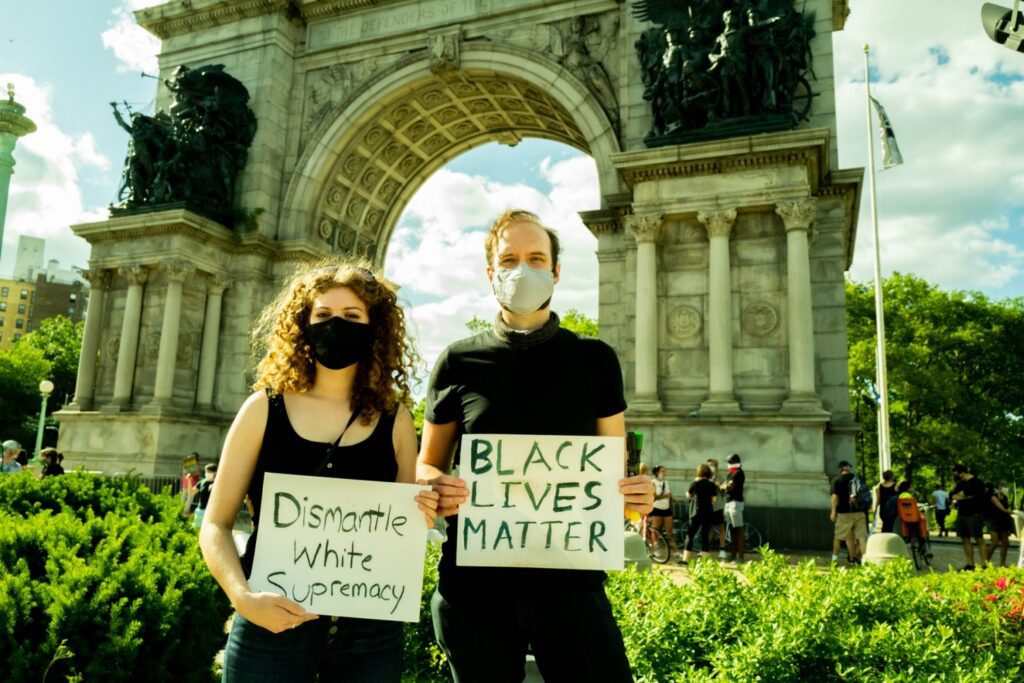
Eva Woolridge for Rolling Stone
Rachael Scheinman, 26, and Gavin Brown, 36 (Long Island)
Rachael: “We’re here to support the march in any way possible, as resources. As white people we are here to take a back seat and give other people the microphone. We created a sign-making station today so people can write what they think. It’s individual and personal. Yesterday I saw less signs out there so I saw a need for people to write their message.”
Gavin: “We’ve had about 50 people stop by. There have been a bunch of kids and a bunch of adults. People just want to be heard. We had our own signs, so we figured why not share and help amplify the voices of everybody around us?”
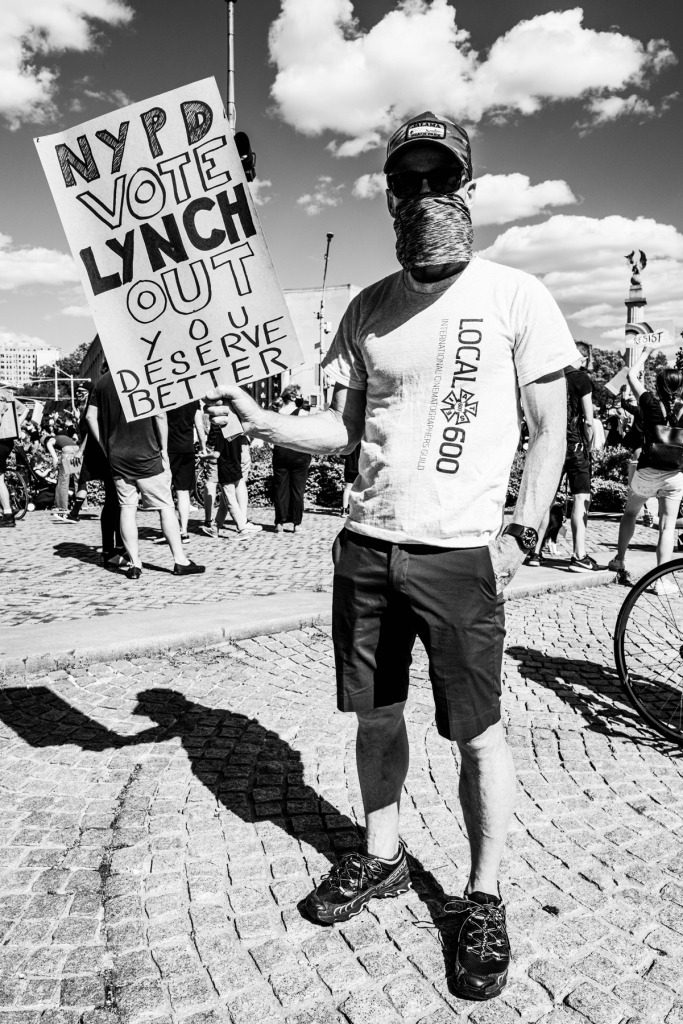
Eva Woolridge for Rolling Stone
Nelson Hume, 58 (Gowanus, Brooklyn)
“I’m asking the NYPD to vote in their union membership to get rid of Patrick Lynch, who is the union head. I think that’s something that can be achievable. It’s the lack of reform that I think prevents the police from being held accountable. It’s like a mom who feels like her kids can do no wrong. The kids are doing wrong, and they need to be held accountable.”
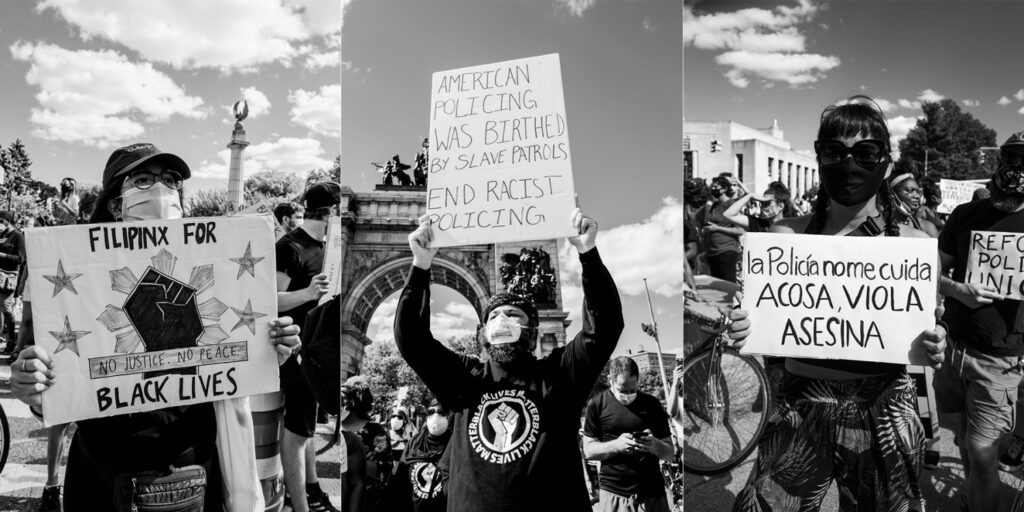
Eva Woolridge for Rolling Stone
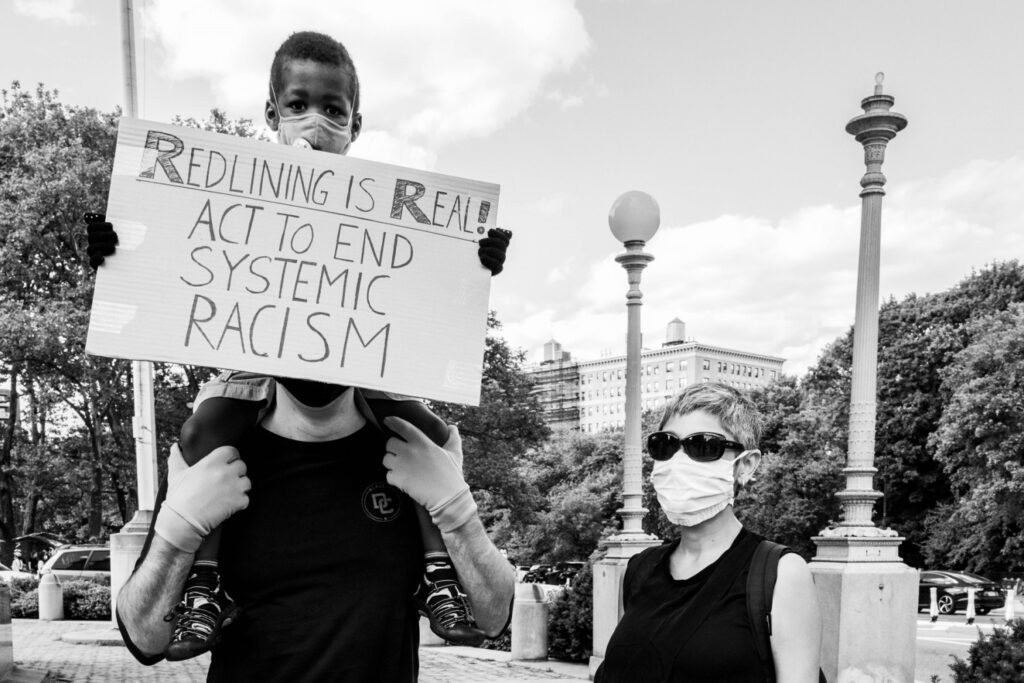
Eva Woolridge for Rolling Stone
Daniel, 43, Richa, 42, and Arjun, 3, Naujoks (Clinton Hill, Brooklyn)
Richa: “Until we moved to Brooklyn, if you told me there were areas where interest rates were different, where what you get in the supermarket is different, I would not have believed it. But it’s true. That’s part of racial justice. This is America. We should have access to the same goods and services at the same prices.
Daniel: “A lot of the protests have been triggered by police brutality and are focused on what the police should be doing and how we should organize law enforcement. But a lot of people are coming out because it is bigger. It is personal. It is political. It is the system that we need to address. Some of the demands are more complex than the need for a person to be indicted and convicted. This is the first step toward justice, but we need to address the systemic issues, which are so much harder to address. What we need in America and the world over is to really understand how pervasive and how complex these systems of racism are. They goes beyond the police, they go beyond the schools, they go beyond access to finance. We have to comprehensively understand what the issues are — allies, everyone in the community — and do our part to overcome institutional racism.”
